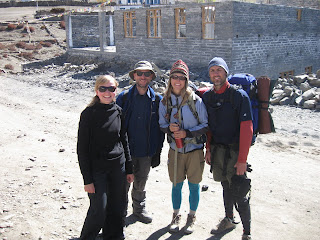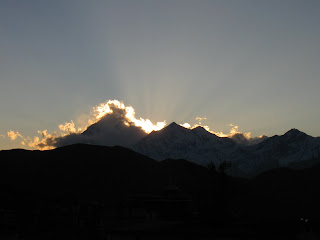The Mona Lisa guesthouse was nondescript but the food was outstanding. One member of our group, Tom, is a chef, and was genuinely impressed with the food quality. Most lodges provide good food and passable versions of various national cuisines. Every once in a while, though, you get lucky and stumble into a place like this where they take pride in their food.
There's a small prep area behind the wall on the right but all the food is cooked on this little stove.

Posters of the da Vinci masterpiece covered the walls. I'm no art expert, so I wasn't able to determine which was the original and which were copies. We were more fascinated by the poster on the wall outside my room.

It says:
We have been let us say, to hear the latest pole.
Transmit the Preludes, through his hair and fingertips.
Transmit the Preludes, through his hair and fingertips.
When I read that I think ... I think ... I think what the heck does that mean? It's even funnier when you look closely at the photo. It appears to be the parking lot of a hotel. It was hilarious how many people stood and stared at the poster, trying to figure it out.
I needed a rest day to give my aching back and feet a break. It was a great place to do nothing. Officially and politically we were still in Nepal, but geographically, linguistically, culturally and ethnically we were in Tibet.
The setting wasn't quite as spectacular as Manang's, but it wasn't bad. Look back at the temple complex and the mountain pass.

Look across the valley at the village of Dzong, which I would walk through the next day.

Look down into the deepest river valley in the world.

Look up at Annapurna, the 10th-highest mountain in the world. (The hospital in the foreground is a reminder that since Muktinath is at the bottom of a mountain pass altitude sickness is a common problem here.)

The numbers of these photos on my memory card are 1044, 1045, 1046 and 1050. They're almost in sequence. You can stand in one spot, turn in a circle, and see all these sights. Incredible.
The village itself was a little shabby and dirty, sad to say. What was especially jarring was the sound of motorbikes. From Muktinath it is possible to travel by road all the way down the trail. I am happy the people in these remote mountain regions have access to modern conveniences. I would never begrudge people the chance to have electricity or celphones or motorcycles.
Having said that...
I don't want to hike in those places.
I don't hike in Nepal to be woken up at 6 a.m. by some knucklehead teenager revving his motorbike in the street outside my window for 20 minutes for no apparent reason.
Here's a funny street scene that illustrates the collision between the traditional and the modern. This was taken from the roof deck of my guesthouse. Power wires hang across the street. In the foreground is a small souvenir stand. In the background is a shop with an internet cafe above. In between is a woman milking a cow in the street.

I took it easy for most of the day, but I did walk up and explore the temple complex. Nepal is primarily a Hindu country. The temple is the second-most holy site for Nepal's Hindus. Inside the walls are both Hindu and Buddhist temples.
There weren't many tourists there when I was there, so I was able to enjoy the solitude of the winding, tree-lined paths as monks, like the one sitting in the shade of the tree on the right, went about their work.

The small Jwala Wai temple is home to a miracle.

Photos are not allowed inside the temple so I'll have to rely on my keen powers of observation and description. Ready? Here we go...
It's a flame on water.
Underneath the altar is a pool of water on which dances a blue flame. It's burned continuously for centuries. It's behind a small grate, which the nuns will open for a small donation. There were no nuns there when I was there, but I was able to view the flame through the mesh. (I still left a donation.)
Hindus view it as a miracle. One hiker I spoke to in town said he thought it was a bit foolish for the people of Nepal to journey all the way to the temple to view what was clearly just a jet of natural gas.
I thought, but didn't say, it was a bit foolish for someone from a primarily Catholic country to travel all the way to the temple just to disparage someone else's religious beliefs.
I met a Hindu priest or sadhu, from India. He was wearing bright orange robes and had a wild, unkempt beard. I desperately wanted to take his picture, and I'm sure he would have let me, but somehow I didn't feel comfortable asking.
He pointed out the cave on the mountainside where he sleeps.

It's the dark smudge smack bang in the center of the photo, sort of cradled between two of the red tree limbs. Annapurna is visible in the distance on the left. Dhaulagiri is wreathed in clouds on the right.
He shares the cave with the temple's Buddhist lama. The sadhu said he's been caring for the lama, who has been too ill to leave the cave. We westerners can certainly learn from the peaceful and easy co-existence of the various eastern religions. There are lively debates about the various strains of Buddhism, for instance, but nobody gets killed because of it.
On the other hand, it was disappointing to see barbed wire topping the fences of the complex. I can't imagine what it was there for. A skilled photographer could probably make a striking image out of the juxtaposition of these two walls: the enclosing wall topped with barbed wire with its implied threat of violence and, just inside and running parallel, a Buddhist prayer wall with its overt message of peace and tolerance.

Just outside the wall is a helipad that was used by the royal family, when there was a royal family.

The next time someone wants to land they'll have to remove the prayer flags first. Just beyond the helipad the path into town is lined with souvenir stands. Here you can buy handmade wool scarves fresh off the loom.
 I bought a couple scarves from this woman, whose name, to my ears, sounded like Bema Tomo. I walked a little ways and someone asked me how much I paid. She told me she'd sell me one cheaper. I didn't need one but the price was so cheap I couldn't say no. I walked a little further and someone asked me how much I paid...
I bought a couple scarves from this woman, whose name, to my ears, sounded like Bema Tomo. I walked a little ways and someone asked me how much I paid. She told me she'd sell me one cheaper. I didn't need one but the price was so cheap I couldn't say no. I walked a little further and someone asked me how much I paid...I finally stopped after buying two scarves for 100 rupees each. That's a handmade wool scarf for about $1.25! I felt like I was stealing. I bought eight scarves for an average price of about $2. The next time I hike there I'm going to hire a porter just to carry trash bags full of scarves. I'm going to buy them all.
Back in town I was happy to learn that everyone we had met on the other side of the pass made it over safely. We did learn, however, that a hiker had died in Muktinath a few days earlier. A Korean girl made it over the pass but was suffering badly from altitude sickness when she arrived. One of the symptoms is loss of coordination. She apparently fell in the shower and hit her head.
All of the stories of trail mishaps have to be taken with a grain of salt, of course, since they are passed by word of mouth up and down the trail. It seems likely, though, that at least four people died on the trail while I was there.
Everyone in my group decided to rest in Muktinath for a day. Paul and Jane, a couple from Ashville, NC that I met in Chame decided to move on. Here they are on the right saying goodbye to Kasia and Rob. I would run into Paul and Jane a few days later in Pokhara.

The sky was blessedly clear of clouds for virtually the entire time I hiked. My second night in Muktinath a wild bouquet of clouds clung to Dhaulagiri at sunset. The view was ... ok.




